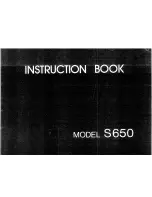
USE AND MAINTENANCE MANUAL
146 1633 000(3)2004-05 A
11
HYDRAULIC OIL LEVEL CHECK
1.
Push the push-button (31, Fig. C). Open the cowling
(4) and secure it safely using the rod (28).
2.
Use the dipstick (11, Fig. U) and check that the
hydraulic oil level in the tank is between the MIN and
MAX marks.
3.
If necessary, top up the hydraulic oil to the required
level after removing the cap (10, Fig. U).
4.
Reinstall the cap (10, Fig. U).
5.
Remove the rod (28, Fig. C) and put in its housing,
then close the cowling (4).
MAIN BRUSH PRESSURE ON THE
GROUND CHECK
1.
Check that the main brush is at the correct height
from the ground, proceeding as follows:
– Drive the machine on a level ground;
– Keep the machine stationary and rotate the main
brush for a few seconds;
– Stop and lift the main brush, then move the
machine;
– Check that the side brush print is, in extension and
orientation, as shown in the figure (1, Fig. J) (the
figure shows the right brush, the left brush print is
symmetrical).
In case the print is not within specifications, it is
necessary to adjust the brush height, proceeding as
described in the following steps.
2.
Slacken the knob (12, Fig. B) and move the limit stop
(13), which is used to lower the main brush.
3.
Perform step 1 again to check the proper adjustment
of the main brush height from the ground.
4.
When the brush is too worn and can no longer be
adjusted, replace it according to the instructions in the
following paragraph.
NOTE
Top up using the same type of oil as the one
in the tank. For the types of oil to use, see
the Technical Data.
NOTE
Brushes with harder or softer bristles are
available. This procedure is applicable to all
types of brushes.
MAIN BRUSH REPLACEMENT
1.
Drive the machine on a level ground and activate the
parking brake using the pedal and the lever (9 and 10,
Fig. B).
2.
Turn the ignition switch (5, Fig. B) to OFF position.
3.
Remove the right door (23, Fig. C) after having
unscrewed the knob (24).
4.
Remove the screws (1, Fig. E) and remove the frame
(2), then move the right side skirt (3).
5.
Unscrew the bolt (2, Fig. F).
6.
Remove the support and the hub (3, Fig. F).
7.
Remove the main brush (1, Fig. F) freeing it from the
left drive hub.
8.
Lift the waste container (1, Fig. W) completely with
the skirt closed, and then carefully free the safety rod
(2) from its retainer (3) and secure it in its housing (4).
9.
Check that the drive hub (1, Fig. G) is free from dirt or
objects (rope, rags, etc.) rolled up in it accidentally.
10. Prepare to fit the new brush, orienting it with the cusp
rake of the bristles (2, Fig. G) as shown in the figure.
11. Install the new brush (3, Fig. G) on the machine and
ensure that its mesh (4) correctly fits on the related
drive hub (1).
12. Place the support, with the hub (3, Fig. F), in its
housing, and tighten the bolt (2).
13. Carefully free the safety rod (2, Fig. W) from its
housing (4) and put it in its retainer (3).
Then carefully lower the waste container (1, Fig. W)
completely.
14. Position the right side skirt (3, Fig. E) and frame (2) in
their housings, and install the screws (1) without
tightening them.
Check that the skirt height form the ground is as
shown in Fig. Q, and then tighten the knobs (1, Fig.
E).
15. Put the right door (23, Fig. C) back in position, and
tighten the handwheel (24).
16. Carry out the main brush pressure on the ground
check, as described in the previous paragraph.
NOTE
Brushes with harder or softer bristles are
available. This procedure is applicable to all
types of brushes.
CAUTION!
It is advisable to use protective gloves
when replacing the main brush because
there can be cutting debris between the
bristles.
















































